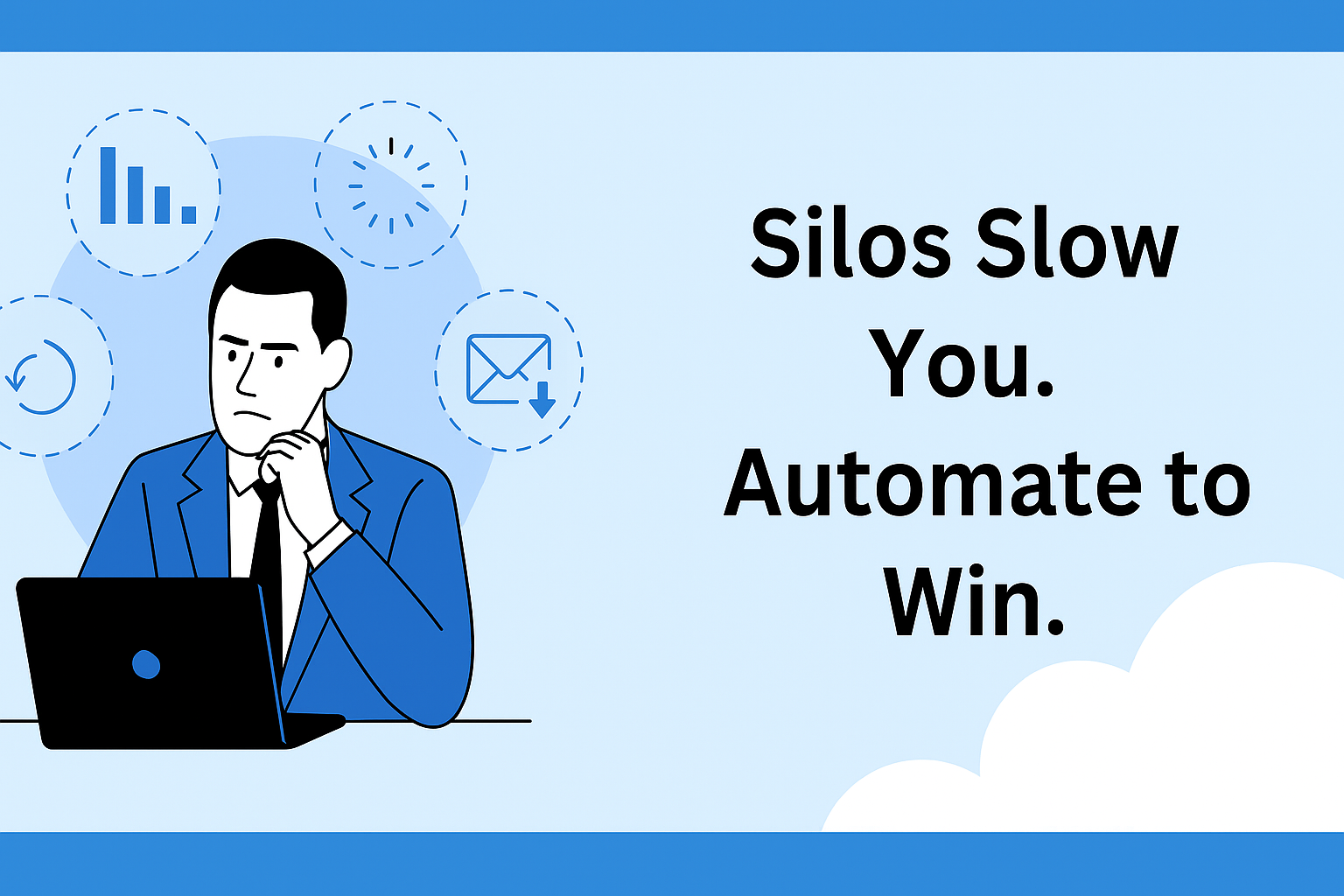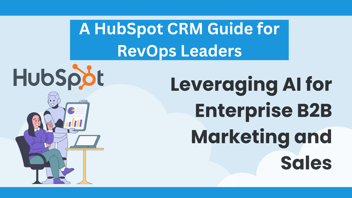A procurement lead at a global industrial manufacturer fires up her tablet after dinner. A LinkedIn roundup catches her eye, she taps through, and a pricing chatbot pops up. Forty minutes later she’s test-driving a sandbox environment; twenty minutes after that, an auto-redlining bot has looped legal into a one-click contract. By dawn, a mid-six-figure order is approved, and a pilot is already live.
The next morning, three internal threads explode:
- Marketing drops screenshots of “high-intent MQLs.”
- Sales claims quota credit and schedules a discovery call—unaware the agreement is signed.
- Customer Success asks who owns onboarding.
Not one thread realizes the deal is done, without hand-offs, despite the process. Meanwhile, the buyer is already posting first-week results to her team’s Slack.
That sprint from click to contract isn’t a freak outlier; it’s the centreline of B2B commerce in 2025. Buyers glide across channels, expecting each touchpoint—content, conversation, checkout, onboarding—to feel like one uninterrupted narrative. Every departmental baton pass we insist on is a pothole they swerve around—or a reason to choose a rival who’s paved the road.
If last night’s invisible sale didn’t hit your dashboard, it’s because your org chart kept the lights red.

The Revenue Leakage Equation
Silos don’t just slow the funnel—they spill it. A recent RevOps audit of 50 SaaS, industrial-tech, and fintech firms quantified four leaks:
|
Leakage Point |
Real-World Symptom |
Cost to Revenue |
|
MQL → SDR context bleed |
Prospect repeats needs; SDR misqualifies |
15–20 % pipeline decay |
|
SDR → AE handoff lag |
Meeting booked a week out; prospect ghosts |
3-week average launch slip |
|
Triplicate AI spend |
Three LLM contracts rewriting the same email |
22 % tool-budget bloat |
|
Managerial drag |
Managers spend 30 % of the week on status decks |
32 % of layoffs target that layer |
*Sources: RevOps Benchmark 2024; McKinsey Global Agility Pulse; CFO Council tooling survey; LinkedIn Workforce Report.
Add it up, and a growth team can lose one in five dollars before the product even gets a chance to disappoint. Meanwhile, each duplicated prompt or GPU hour lines a vendor’s pocket instead of compounding into ARR. That’s not “room for optimisation”—it’s a live bleed.
Boards stare at ARR/FTE and ask why head-count climbs while per-employee yield crawls. The answer isn’t marketing spend or quota coverage; it’s leakage baked into the org chart itself.

Latency Layers & The Cost of Re-Explaining
Speed-to-lead once meant calling back in five minutes; now the entire buyer journey can close in five minutes if you’re not blocking the exits. LeanData’s latest survey shows that opportunities convert 391% better when engaged within one minute. In our opening story, that window slammed shut long before “discovery.” Every form fill and routing rule layer minutes onto a journey measured in seconds.
A TelBit study illustrates the compound drag:
|
Stage |
Avg. Internal Processing Time |
Context Lost (%) |
|
Lead capture to SDR |
6 min |
12 % |
|
SDR to AE hand-off |
14 min |
18 % |
|
AE to CSM intro |
1 hr 12 min |
27 % |
By the time the new logo meets its “owner,” nearly half the original context is gone, replicated, or contradicted. Each re-explaining moment bleeds buyer trust and invites the autonomous competitor who never asks twice.

Departments weren’t maliciously designed to slow us; they were optimised for a memo-pad era when information travelled on foot. In a binge-watch economy, every extra layer is a buffering wheel that the viewer escapes with one swipe.
Why Departments Became the Bottleneck
In the 1990s, the problem was scale: too many assembly-line tasks for one manager to track. The solution was vertical layers—marketing sparks interest, sales closes, and service keeps churn down. Paper moved in envelopes; people moved the paper.

Fast-forward. Buyers binge research, compare, trial, and buy in a single sitting—often outside business hours. The funnel is no longer linear; it’s a feedback loop where discovery, usage, and advocacy overlap. Yet our org charts still resemble the pneumatic-tube diagrams they replaced.
The result is the worst of both worlds:
- Latency is inherited from paper workflows.
- Overhead inflated by software licenses that duplicate across silos.
- Customers experience friction as forced introductions and redundant forms.
Modern growth isn’t hindered by a lack of ads, demos, or onboarding webinars; it’s limited by the mental model that those functions must reside in separate kingdoms.
Breaking the bottleneck requires a new operating system: cross-functional Pods that own outcomes, customer-journey Fronts that replace departmental labels, and an agentic orchestration fabric that coordinates humans and AI in real time. That system is what the next sections will build, step by step, metric by metric.
Pods, Fronts & Agentic Orchestration: The New Operating System
Departments treat expertise like separate rooms; pods treat it like a Swiss Army knife that you carry everywhere. A Pod is a six-to-eight-person strike team that owns one outcome and one KPI. No hand-offs, no “ask design to review,” no “wait for RevOps.” Success or failure lives inside the same Slack channel.
|
Front |
Customer Moment |
Pod’s North-Star KPI |
|
Activation |
First verified “aha!” |
Activation-Rate |
|
Expansion |
New $ from active users |
Net ARR from existing logos |
|
Retention |
Renewal decision |
Gross Revenue Retention |
|
Advocacy |
Referral or public praise |
NPS-driven SQLs |
Four Fronts replace three departments because they mirror how buyers actually feel value forming, growing, sticking, and echoing.

But Pods still need coordination. Enter the Service Orchestration & Automation Platform (SOAP)—a policy-aware fabric that routes every task to the cheapest, safest resource in milliseconds.
SOAP in one breath:
- Scheduler chooses the right model or human.
- Policy injector wraps brand voice, PII masking, and token limits around every call.
- Observability streams cost, latency, and risk to a live dashboard.
- The fallback router sends low-confidence jobs to a safer model or Pod Coach.
In practice, Marketing, Sales, and Success become legacy tags—like “dial-up” or “fax.” Pods sit on top of SOAP rails, drawing talent from Communities of Practice (CoPs) when depth is needed, but never relinquishing outcome ownership. The result is speed without chaos and governance without drag.
Field Proof: Gainsight, Bosch & Spotify
Gainsight — Activation Lift
When Gainsight realised that 42% of “closed-won” logos never reached their first value, they combined growth PMs, CSMs, and a prompt engineer into one Activation Pod. With SOAP routing product telemetry directly to an onboarding agent, activation increased from 39% to 61% in two quarters, and the ARR forecast was beaten by $7 M.
Bosch IoT — Cycle-Time Crash
Bosch’s industrial-IoT division faced a 10-week average from concept ticket to live firmware. They stood up a cross-functional Expansion Pod wired to a FinOps-guarded LLM that autogenerates proposal docs and safety checklists. Firmware lead time fell to 3 weeks, unlocking a €34M pipeline that was previously written off as “too custom.”
Spotify — Velocity at Scale
With over 400 squads, Spotify is a pod on a planetary scale. A 2024 internal review revealed that squads were running 2.7 times the experiment volume of comparable function-first teams, while employee engagement scores were six points higher. McKinsey’s Teams-of-Teams benchmark echoes this: enterprises that shift half their revenue to outcome squads see a 30% reduction in cycle time.
The thread connecting all three: cross-functional Pods, unified Front KPIs, and an orchestration layer that logs every token and decision. No heroics—just systematic velocity.
What’s at Stake If You Hesitate
Governance Drag: Three siloed LLM stacks mean triple the red-team effort and triple the subpoena exposure. One public hallucination can erase months of PR spend.
Talent Flight Top ICs want to ship, not shuttle decks between VPs. LinkedIn data shows attrition +12 pp for mid-career specialists trapped in approval queues.
Valuation Squeeze Investors now benchmark ARR per employee and Net Dollar Retention. Companies stuck below the Pod curve watch their EV/Sales multiple leak until an activist demands “AI restructuring.”
Against those risks, adopters are pocketing compounding upside:
- ARR/FTE +30 % inside a year.
- Churn –31 % when Retention Pods own risk before it blooms.
- Experiment velocity is 2–3 times as SOAP removes batch-cycle friction.
The opportunity cost of waiting is measured not in missed hype cycles but in hard valuation points and talent you won’t re-hire.
60-Minute Audit & 90-Day Pilot Checklist
One-Hour Org Audit
- Context-loss timer — shadow three leads from form fill to first human; log minutes and repeated questions.
- Duplicate prompt scan — grep code base for identical GPT calls; tag wasted tokens.
- Managerial layer map — count hand-offs between idea and production deployment.
If any metric feels painful, you’re ready for the pilot.
90-Day Activation-Pod Pilot
- Pick one ICP slice with clean funnel data.
- Assemble a six-person team (growth, PM, SDR, onboarding, analyst, AI-wrangler).
- Wire the KPI wall — Activation-Rate + 3 lead indicators.
- Spin up SOAP sandbox — policy injector, observability, fallback routing.
- Run four sprints; publish weekly experiment logs.
- Compare vs. control on Day 90: goal ≥ 20 % activation lift.
- Decision gate — lift hit? Replicate to Expansion Pod; lift missed? Patch data or skills, rerun.
Tackle that audit today, and by next quarter, you’ll have hard numbers that prove to the board why departments belong in the museum—right next to fax machines and Rolodexes.
Call-to-Action Close
Picture a Friday where every experiment the Activation Pod sketches at 9 a.m. is live and A/B-testing by noon; where the KPI wall shows lift in real time while your CFO watches token costs stay green; where no customer ever re-introduces themselves because the walls they once bounced off no longer exist. That Friday starts the moment you spin up your first Pod. Gauge exactly how close you are by taking our AI Readiness Assessment, then map the next 90 days with the help of our expert Pod-and-Orchestration Services. Speed compounds—claim the first turn of the flywheel today.
Conclusion & What’s Next
We’ve seen why classic departments bleed revenue, how Pods and Fronts realign the customer journey, and why an AI-native orchestration layer turns velocity into a repeatable advantage. We ran the numbers—15–20% pipeline decay, 30% ARR/FTE lift—and mapped a 90-day pilot that any team can start this quarter.
In Part 2 of the series, we’ll roll up our sleeves: team size, Pod roles, KPI walls, SOAP kernels, and the governance hooks that keep speed from outrunning safety. Expect checklists, real dashboards, and field-tested prompts.






Leave a Comment